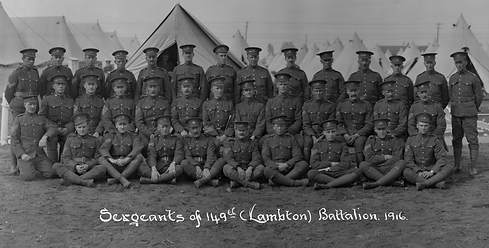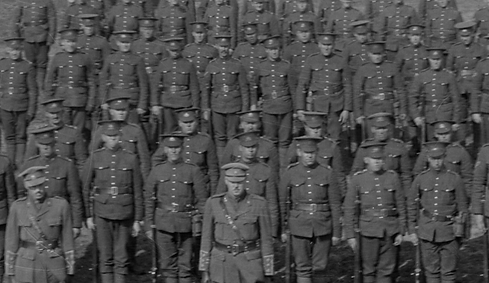
Photo: 149th Battalion at Camp Borden, 1916 - Source: Library and Archives Canada/Andrew Audubon Merrilees fonds/e010931962
The 149th Overseas Battalion
Lambton's 149

The 149th Overseas Battalion was established for service in the First World War in Lambton County, Ontario starting in 1915. Its soldiers were posted to the 4th and 25th Reserve Battalions upon arrival in England in 1917, and went on to serve across several units during the war.

Origins
The 149th was first authorized in November 1915, under the command of Lieutenant-Colonel (LCol) Robert G.C. Kelly of Watford, Ontario. The intent of the Minister of Militia, Sir Sam Hughes, was to have county-based battalions recruit and train in order to support the Canadian War Effort. The 149th began recruiting soldiers from across Lambton County, everywhere from Thedford to Port Lambton, and everywhere in between.


Recruiting
Recruiting was initially stood up in Sarnia, Petrolia, Watford, and Forest, but later expanded to include stations in smaller communities including Brigden.
Due to supply delays, it was not uncommon for new recruits to work and train without issued uniforms or kit for up to two weeks after enlistment. Training often began in training sections established in the villages and towns of the county before collective training at higher levels.

Command
The first Commanding Officer (CO) of the 149th was LCol Doctor Robert G.C. Kelly, from Watford, Ontario. Upon his sudden death from a brain hemorrhage on 11 December 1915, command passed to then-Captain Thomas Pinkerton Bradley.
Capt Bradley had been a doctor in Sarnia for 12 years, and was serving with the 2nd Field Ambulance at the time. He was appointed the rank of LCol upon assuming the role of CO of the 149th. On 24 September 1916, LCol Bradley resigned, and was succeeded by then-Major MacVicar from Sarnia, Ontario (who had been the Senior Major of the 149th since 1915). His command was intended to be temporary while a new CO was found. However, Major MacVicar was soon after promoted to LCol, and assumed permanent command of the 149th Battalion.
LCol MacVicar was the CO until the Battalion arrived in England in 1917.
The Cap Badge
The 149th Battalion originally wore the standard Canadian Expeditionary Force cap badge. LCol Bradley felt a more distinct cap badge would help instill a sense of pride in the soldiers in their Battalion. Initially, LCol Bradley introduced a contest in which the designer of the battalion badge would be awarded a $10 gold coin. The contest seems to have been open not only to military members, but the public as well. The contest concluded on 31 March 1916, and the badge draft was submitted to Ottawa.
On 5 June 1916, the proposed badge was approved. A message was sent on 10 June to inform LCol Bradley. The badges were procured, and the Officers and members of the 149th were badged in time for the 29 September 1916 photos.


Deployment
The 149th Battalion deployed to England on 28 March 1917 aboard the S.S. Lapland out of Halifax. Upon arrival, the soldiers and officers were divided. The soldiers were assigned to the 25th Reserve Battalion to await deployment to the field. The officers were posted to various units, none remaining with the 25th Battalion or the soldiers of the 149th.
Division and Disbandment
The soldiers from the 149th were separated, but would deploy across a variety of Canadian units. Units included the 1st Bn, 2nd Canadian Mounted Rifles, 8th Bn, 18th Bn, 47th Bn, 49th Bn, 60th Bn, the Canadian Engineers, the Canadian Forestry Corps, and the Canadian Machine Gun Corps.
On 11 April 1918, under Privy Council order 3187, the 149th Overseas Battalion was officially disbanded. By that time, there were no soldiers or officers officially posted to the Battalion. The Battalion Colours were deposited at the Sarnia Courthouse, later being held by the Lambton Archives.


Brigden and the 149th
The following are members of the 149th
connected to Brigden, Ontario:
Frank James Bastow
Lyall Wellington Bennett
Rodman Roy Bennett
Thomas Alexander Brimacombe
Leo Bidwell Dennis
Clifford Reed Duncan
Edward James Fourney
Frank Hamilton
Wilfrid Keene
Frank Kilbreath
Frederick William Lillywhite
James Melburn McDonald
Norman Kimball McDonald
Wilfred Wellington McGregor
Clarence Lloyd McLean, DCM
Arthur Welsley Murphy
Morris William Murphy
Albert Elroy Nelson
Ernest John Pinel
Guy Edgar Postill
Frank Knill Price
Frederick William Raper
George Henry Regan
Clarence Shaw
Robert George Silver
Robert James Alexander Sinclair
Mason Clark Taylor
Carlton Michael Ward
Lorne Cecil Witherell
John Sheppard Young, MM
Training
The initial training standard was a 10-week course covering drill, weapons handling, route marching, entrenching, bayonet fighting, and other essential topics. Completion of the 10-week course would be followed by collective training at the company level.
Route marching was both a training tool for the soldiers, and a recruiting tool for the CEF, with up to a company-sized element of soldiers marching across long distances throughout the county. It increased visibility, and in multiple cases enlisted local organizations to provide warm meals for the troops.
The 149th Battalion departed Lambton County for London, Ontario on 29 May 1916 for further training. Following their time in London the Battalion was moved to Borden, Ontario on 9 July 1916.
With preparations complete, the 149th Battalion departed by train to Halifax, Nova Scotia on 22 March 1917 to deploy overseas.

Battalion Photos, 1916









Sources
Photo: 149th Battalion at Camp Borden, 1916 - Source: Library and Archives Canada/Andrew Audubon Merrilees fonds/e010931962
Photo: Officers of 149th O.S. (Lambton) Battalion, Camp Borden, 1916 - Source: Library and Archives Canada/Andrew Audubon Merrilees fonds/e010932666
Image and Information: The Sarnia Canadian Newspaper, May 26th 1916 - Source: Image courtesy of Lambton Heritage Museum, Grand Bend. from the article "The 149th Battalion"
Image - Photograph of the Cap Badge of the 149th Battalion - Source: Photographed by Sean Maas-Stevens, badge held on display at the Royal Canadian Legion Branch 635
Image and Information: Canadian Expeditionary Force - 149th Battalion - Nominal Roll of Officers, Non-Commissioned Officers and Men - Source: Library and Archives Canada/Government of Canada/e011087758
Photo: Sergeants of 149th Battalion (Lambton) at Camp Borden, 1916 - Source: Library and Archives Canada/Andrew Audubon Merrilees fonds/e010931929
Image - Battalion Colours of the 149th Battalion - Source: Image courtesy of Lambton Heritage Museum, Grand Bend.
Photo: "A" Co,. 149th Battalion, C.E.F, London, ON 1916 - Source: Library and Archives Canada/Andrew Audubon Merrilees fonds/e010931944
Photo: "B" Co., 149th Battalion, C.E.F, London, ON 1916 - Source: Library and Archives Canada/Andrew Audubon Merrilees fonds/e010932019
Photo: "C" Co., 149th Battalion, C.E.F, London, ON 1916 - Source: Library and Archives Canada/Andrew Audubon Merrilees fonds/e010932020
Photo: "D" Co., 149th Battalion, C.E.F, London, ON 1916 - Source: Library and Archives Canada/Andrew Audubon Merrilees fonds/e010931945
Photo: Brass and Bugle Band, 149th Battalion, C.E.F, London, ON 1916 - Source: Library and Archives Canada/Andrew Audubon Merrilees fonds/e010932796
Photo: Rugby Team of 149th Battalion, C.E.F, 1916 - Source: Library and Archives Canada/Andrew Audubon Merrilees fonds/e010931947
Information: Miller, Allan Kenneth, The 149th Canadian Expeditionary Force Lambton's Own - 15 June 2023 - https://issuu.com/lclibrary/docs/the-149th-canadian-expeditionary-force-lambtons-ow
Information: Personnel files of the members of the 149th hosted on Library and Archives Canada's website, including those specifically listed above. Their service details are further expanded upon in their individual biographies hosted on this website, or currently in draft.
Information - https://www.bac-lac.gc.ca/eng/discover/military-heritage/first-world-war/Documents/infantry%20battalions.pdf
